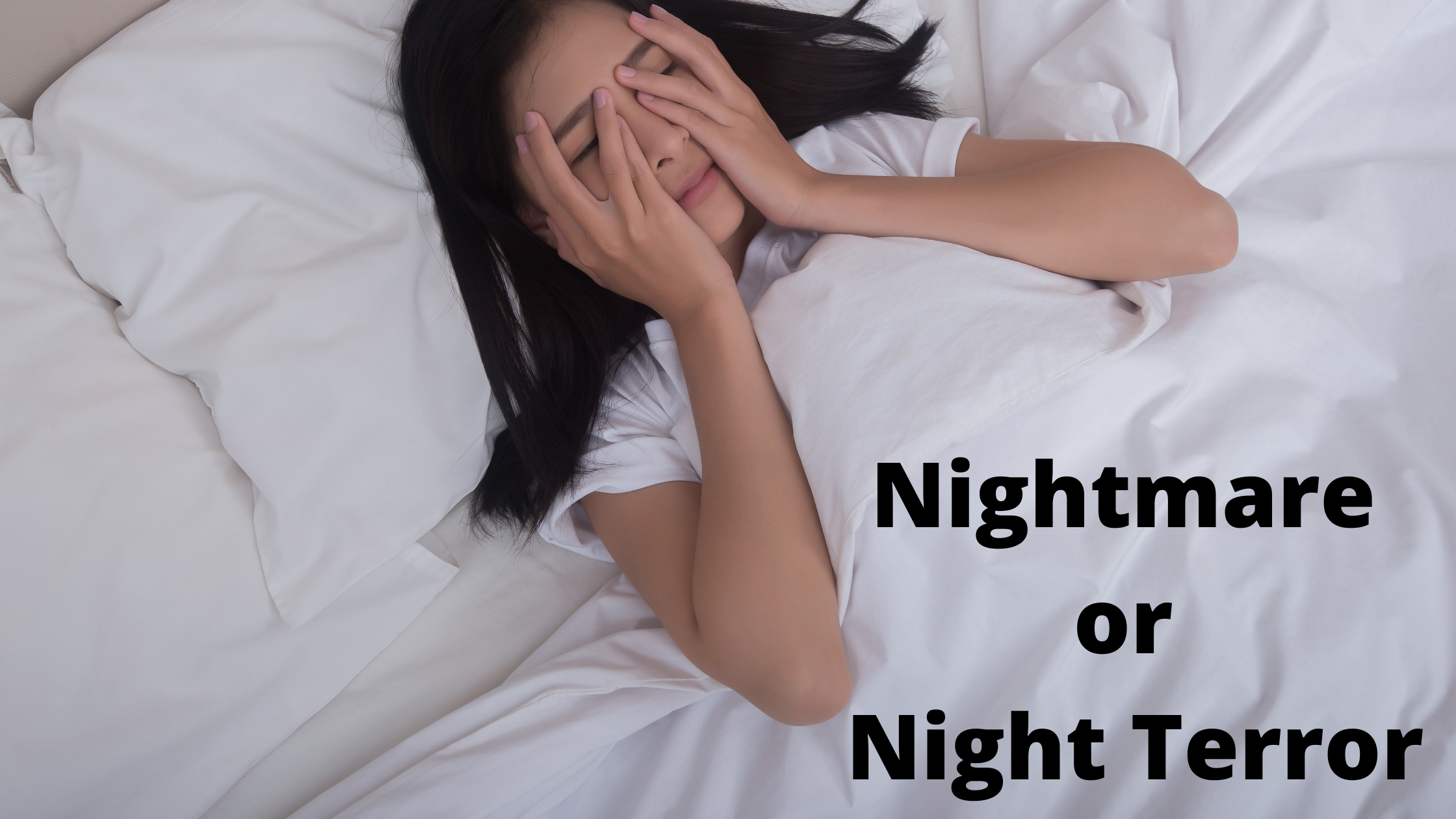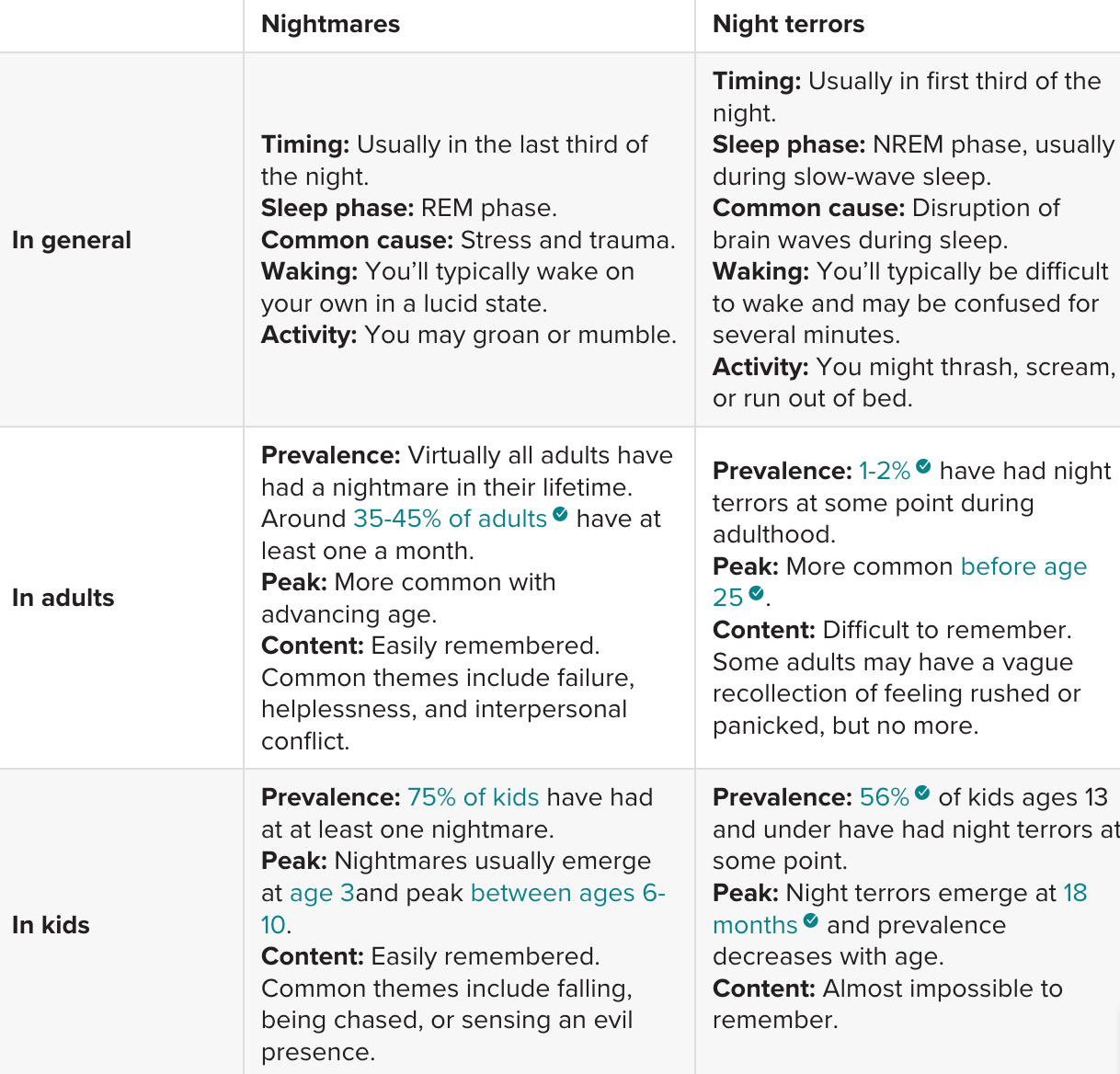
Nightmares and night terrors may easily be confused with one another because they share some similar features. They both can be frightening and cause trouble going back to sleep and/or staying asleep. But it's important to understand the difference between them as they are two different events. This can really impact how they are both treated as well. Continue reading to find out more about these two different sleeping events and what do do about them.
What's the difference?
Nightmares are terrifying dreams that may wake you up, or that you may sleep through. Either way, you remember it,and are able to recall it. These dreams can be very vivid and feel like you are experiencing it in real life, causing you to wake up and feel frightened or distressed.
The biggest feature about nightmares is that you can recall them and that they take place in rapid eye movement sleep, or REM. This is the stage of sleep where dreaming normally takes place.
Night terrors, however, are episodes where you partially awake from non-REM sleep stage 3. Normally during this period, you are deep asleep, and not dreaming. They involve extreme stress, like screaming or waving your limbs. You won't remember night terrors, but may wake up to signs that you were moving throughout the night, such as knocked over items or frightened family members.
Below is a graph that further delineates the differences between them:

Credit: https://www.healthline.com/health/sleep/night-terrors-vs-nightmares#whats-the-difference
Nightmare Causes
Stress and Trauma
Nightmares are dreams that stem from stress and trauma. Nightmares may be the way that your brain rehearses responses to danger is one theory of why we have them. Nightmares may also just be a symbolic representation of something bothering you in real life. They are common after a traumatic event, as many individuals with post-traumatic stress disorder (PTSD) often experience recurring nightmares over whatever stressed them out the first time.
Early Childhood Experiences
If something traumatic happens to you as a childhood, your brain may respond by rushing through development, making you less able to control negative emotions while sleeping. This could be the reason that you have nightmares, and that some of them reflect something that may have happened in your childhood. The experience is normally something that is quite unpleasant enough to persistent throughout life in your memories.
Medication
Certain medications increase your chances of having nightmares. These include beta-blockers, dopamine agonists, and selective serotonin reuptake inhibitors (SSRIs).
Night terror cause
Night terrors take place deep in sleep, in a phase called slow-wave sleep. Those with frequent night terrors tend t have mismatched brain waves during this phase of sleep. When the brain waves oppose one another, it can cause a slight arousal where your body goes from still to actively moving, heart racing and muscles tense. However, consciously, you are still asleep and unaware of what is going on.
Factors that contribute to night terrors include genetics, family history, sleep disruption, and medication.
How to Recognize them
It's important to recognize the difference between nightmares, night terrors, and other nighttime events in case you ever need to see a health professional. The better you can describe them, the better your diagnosing and treatment process will be.
The first thing is to be able to tell the difference between a bad dream and a nightmare. A bad dream is simply unpleasant and can be slept through. Nightmares trigger a sense of danger, and most likely will wake you up.
Secondly, knowing the difference between nightmare and night terror are very important. Night terrors normally happen early in the night and can last anywhere from 30 seconds to 5 minutes. Nightmares happen early in the morning and you will likely be alert and able to remember the dream very clearly.
Thirdly, it's important to know the difference between night terrors and sleepwalking. They both take place during the same phase of sleep, but actively involve you leaving the bed and walking around without any conscious awareness that you are doing this. Night terrors involve distress more than actual movement. Sleepwalking doesn't involve string emotions and signs of having left the bed are key indicators of sleepwalking.
Treatment and coping
There are some lifestyle modifications that you can take to reduce your sleep disruptions. Lowering your daytime stress levels and limiting your alcohol are keys. Practicing good sleep hygiene and getting enough sleep every night may also be some good practices that you can do to help reduce the amount of disruptions to your sleep.
If you have children that are experiencing these things,the first step is to get them to settle down. Once they are calm, you can do things like leave all the bedroom doors open and increase their level of security. For night terrors, they will be difficult to awake. It's best to not intervene unless their safety is at risk. If they have walked around the room, wait for the episode to end before gently guiding them back to their bed.
If these events are causing severe disruption in your life and sleep, then it may be time to get professional sleep. Injuries, severe underlying stress, and anxietities revolving around sleeping can also be signs that advanced support is needed.
Treatment may include image rehearsal therapy and talk therapy are key for nightmares. Scheduled awakenings, psychotherapy, relaxation therapy and hypnosis may be the best interventions for night terrors.
If you or your family member needs to see a sleep health professional, then please click the orange button below to take a free online sleep quiz and speak with someone at our facilities.
https://www.healthline.com/health/sleep/night-terrors-vs-nightmares#getting-support

